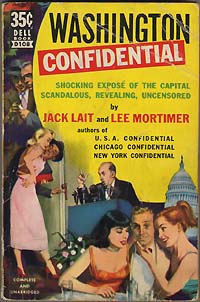By Brennen Jensen (Baltimore City Paper, 11/8/2000)
 “Aristocratic, historic Baltimore is the slumming-ground for thousands of escaping Washingtonians.”
“Aristocratic, historic Baltimore is the slumming-ground for thousands of escaping Washingtonians.”
Such a statement could have been written yesterday, given the number of D.C.-area residents who regularly hammer up Interstate 95 for a ball game or a night of drunken debauchery on our fair streets. But there’s nothing new under the sun: The above was written 49 years ago by journalists Jack Lait and Lee Mortimer, two New York Daily Mirror scribes who churned out a series of sensationalized burg-bashing best sellers in the early ’50s exposing the seedy underbelly of the Eisenhower era. Their trash-talking tomes include New York Confidential, Chicago Confidential, and USA Confidential. (The pair could find filth anywhere; the national book has a chapter titled “Bloody Kansas–silos and sex!”) It’s likely the rakish reporters’ blistering books overturned rocks on a good bit of honest-to-God skullduggery, graft, and political corruption, but the overheated prose is so clearly designed to titillate milquetoast Middle America that much of their muckraking is hard to take seriously.
Today their works are largely campy hoots that evoke a hard-boiled world of clip joints, B-girls, and smoke-choked gambling dens–think low-budget film noir. Alas, modern readers will also find the pair’s potboilers to be xenophobic, racist, misogynist, and homophobic. (There’s a heady whiff of McCarthy-esque Red paranoia in the pages as well.) I guess we’re lucky this duo of sleaze jockeys never penned a full-length “Baltimore, Confidential,” but a 19-page chapter bearing that name is tucked at the end of 1951’s Washington Confidential, a dog-eared copy of which I recently obtained from a friend.
“Baltimore is perhaps the perfect example of a Mafia-controlled city in action,” Lait and Mortimer assert early on in their Mobtown dismemberment. After discussing the dubious nature of the city’s political machinery–dropping the names of Bill “Boss” Curran, state Sen. Herbert O’Conor, Gov. Theodore McKeldin, and Mayor Thomas D’Alesandro–they get even nastier. “Baltimore is overrun with rubes,” they write. It’s a “yokel cosmopolis” where “guttered drunks and streetwalkers . . . are a common sight on every corner.”
Naturally this pair of smut seekers wind their way to the Block, the strip-joint-lined section of East Baltimore Street they bill as “one of the most vicious and lawless areas in the world.” They bounce from basement dive to shoddy strip club to no-tell nightclub, encountering everything from droopy-bosomed “elderly relics” to an 18-year-old who, for a dollar tip, “let you play around and never slap your hands.” They also chuckle at the proliferation of store signs proclaiming the availability of “sanitary rubber goods” or “sanitubes.” (Condoms, it seems, weren’t available at the local Safeway back in ’51.) And they spy–shock! horror!–“playing cards with naked females on the cover.”
The gumshoe reporters eventually explore the “better region” along North Charles Street, then home of the town’s largest legit nightclubs–the original Club Charles (Preston and Charles streets) and the Chanticleer (now the Hippo, at Charles and Eager streets). But even here the intrepid pair finds “private cheating flats,” where “chumps are steered . . . for girls, booze, and stud poker.” Greenmount Avenue is tantamount to the Las Vegas strip, home to gambling dens from midtown through Waverly. While the writers comments regarding African-Americans are rarely charitable, after exploring Baltimore’s black nightlife they conclude that “some of the cleanest and best nightclubs in town are the black-and-tan resorts in the Pennsylvania Avenue district.”
“Provincial,” “a backwash,” “dirty,” “smoke-grimed”–such are the ways the notebook-wielding New Yorkers described our town. Perhaps the kindest passage in this curt civic assault comes on the final page: “In thousands of uniform flat-front red brick homes with the balustradless white stoops, unique to Baltimore, live good, solid people, white and Negro.” But Mortimer and Lait just can’t leave well enough alone, concluding “Baltimore Confidential” thusly:
“Most citizens are openly on the side of the lawbreakers, [and] the concepts of liberty and non-interference play into the hands of the hoodlums and harpies. At this writing any and all forms of vice are tolerated and protected. There is a price for everything, and it’s not much. In fact it costs only $500 to jump to the top of police promotions list.”
